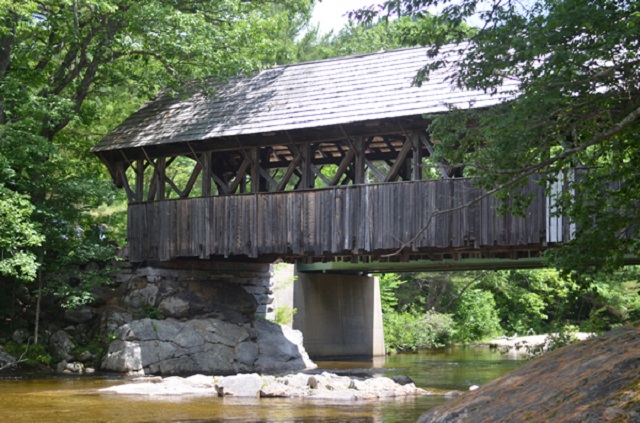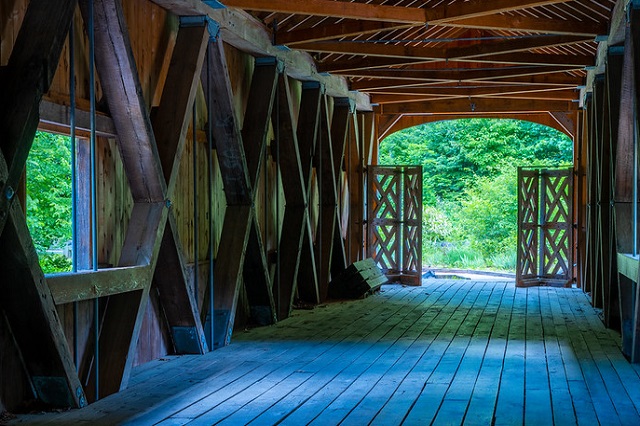If you’re driving through New England, you’re bound to find more than a few covered bridges along your route – and you’ll be glad you did. They serve as a picturesque reminder of olden times.
Yes, they’re beautiful, but when most covered bridges were built back in the mid-1800s, they were all about being practical. The roofs kept rain and snow off the wood and prevented decay, thus keeping the structure safe. Sadly, the number of covered bridges is dwindling.
Here are some of the best covered bridges still dotting the New England landscape.

The Artist’s Bridge
Newry, Maine
Built in 1872, this covered bridge was originally named the Sunday River Bridge for – you guessed it – the river that it spans. The origins of its nickname are up for debate. Some say it earned the name for being one of the most photographed and painted covered bridges in Maine. Others say this 87-foot long bridge got its nickname because impressionist painter John Enneking often painted in the spot. Either way, it’s a beautiful structure that’s on the National Register of Historic Places. You can no longer drive across the bridge, but it is open to foot traffic.
The Robyville Bridge
Corinth, Maine
This covered bridge spans the Kenduskeag Stream in a section of Corinth known as Robyville Village. It’s 73-feet long and was designated as a Maine Historic Engineering Landmark in 2002. Built in 1876, the Robyville Bridge is most notable for being the only completely shingled covered bridge in Maine. The structure was reinforced as part of a major rehabilitation in 1984, so you can drive your car over it just horses and buggies once did.
Cornish-Windsor Covered Bridge
Cornish, New Hampshire; Windsor, Vermont
There are over 60 covered bridges in New Hampshire. The longest and most impressive of the lot is the Cornish-Windsor covered bridge, which runs across the Connecticut River into Vermont. At 449.5 feet in length, this is the longest wooden bridge in the country. It’s also the longest two-span covered bridge in the world, so it’s not to be missed.
Albany Covered Bridge
Conway, New Hampshire
The Albay Covered Bridge was constructed back in 1858 and is arguably one of the most scenic bridges in New Hampshire. It’s located in the White Mountains along the Kancamagus Highway, one of the most scenic roads in the Northeast. This bridge closes during the winter but is open to foot traffic all year long.
Arthur A. Smith Bridge
Colrain, Massachusetts
Measuring 100-feet long and open to pedestrians and cyclists, the Arthur A. Smith Bridge is the only Burr arch truss bridge in Massachusetts and the last covered bridge in the town of Colrain, which once boasted 12 covered bridges. Originally built in 1869 and named for a then-prominent local resident, flood damage saw it largely abandoned until the town voted to rebuild and move the bridge to its current location in 1896.
Ware-Hardwick Covered Bridge
Gilbertville, Massachusetts
This covered bridge was built in 1886 and has been closed and refurbished several times throughout the years. It was listed on the National Register of Historic Places in 1986 and is one of the few 19th-century covered bridges still in existence in the Bay State. It measures 137 feet long and is open to traffic, although it can only manage a single lane of cars at a time.

Pulp Mill Covered Bridge
Middlebury, Vermont
Pulp Mill is one of the oldest covered bridges in Vermont. Its exact year of construction is unknown, but it has a history of repairs and refurbishments dating back to 1860. It is also one of the state’s few double-barrel bridges. Instead of one opening for traffic, there are two so each direction has its own lane, making the entrance look a bit like a double-barrel shotgun.
West Dummerston Covered Bridge
Dummerston, Vermont
Measuring 280 feet long, West Dummerston is the longest covered bridge located entirely within in the state of Vermont. It was built in 1872 by Caleb Lamson, a master builder of his time, to span the West River. The bridge’s intricate woodworking includes town lattice trusses and diamond-shaped openings that look beautiful from the outside and add light to the inside.
Swamp Meadow Covered Bridge
Foster, Rhode Island
This is the only covered bridge on a public road in Rhode Island and it’s also rather new. It was devised of in 1986 to celebrate the state’s 350th anniversary. The work was done by volunteers and intended to replicate 19th-century styling. Shortly after opening in 1992, the bridge was burned by arsonists, but volunteers immediately came right back out to rebuild. The current 40-foot bridge was dedicated in 1994 and is open to traffic.

Comstock Covered Bridge
East Hampton, Connecticut
The Comstock Bridge was built in 1785 as an uncovered bridge but received an upgrade with a roof in 1873. It needed significant reinforcements in the 1930s since it wasn’t originally built with a roof in mind. The bridge got its name from the town’s first postmaster and still has much of the original wood mixed in with the newer pieces that were added over the years.
Bull’s Bridge
Kent, Connecticut
This covered bridge is 109 feet long and spans the Housatonic River. It’s tucked away in a beautiful, wooded area with ample trails for hiking and exploring. It’s one of only three public highway covered bridges in Connecticut, and one of only two that accept vehicular traffic. A bridge has spanned this spot in the river since the mid-1700s with the current bridge dating back to 1842.
The bridges are waiting, now all you need is a ride. Good thing AAA members can save up to 20% on Hertz rentals.
2 Thoughts on “A Tour of New England’s Covered Bridges”
Leave A Comment
Comments are subject to moderation and may or may not be published at the editor’s discretion. Only comments that are relevant to the article and add value to the Your AAA community will be considered. Comments may be edited for clarity and length.

















There is another covered bridge in the town of West Cornwall, Connecticut (not to be confused with Cornwall Bridge, a town about two miles south that does NOT have a covered bridge). West Cornwall is about 10 miles north of the Kent covered bridge. The West Cornwall covered bridge is 172 feet long and was built in 1864; there has been a covered bridge at that location since 1762. The West Cornwall bridge spans the Housatanic River and is part of State Route 128. It is located where US 7 and State Route 128 meet and the bridge carries traffic to the center of town. In addition to being an historic attraction, the West Cornwall covered bridge is an integral part of the public road system and is used on a daily basis. This fact alone makes it unlike most covered bridges and is why this particular covered bridge receives continual maintenance. The West Cornwall covered bridge is in a particularly beautiful setting and is especially attractive when viewed with the quaint town of West Cornwall in the background.
Every time I go to visit my eldest brother, I go through Buskirk, NY, which has a lovely, well maintained covered bridge. But I noticed an error in your first paragraph: You said that the bridges were built to keep snow off, which extended the life of the bridge. The great muralist and authority on Americana, Eric Sloane said (in his book, “Diary of an Early American Boy”) that snow had to be shoveled into covered bridges in the winter. Remember that in the winter, travelers rode in sleighs. A bridge that was free of snow would have brought them to a dead stop.